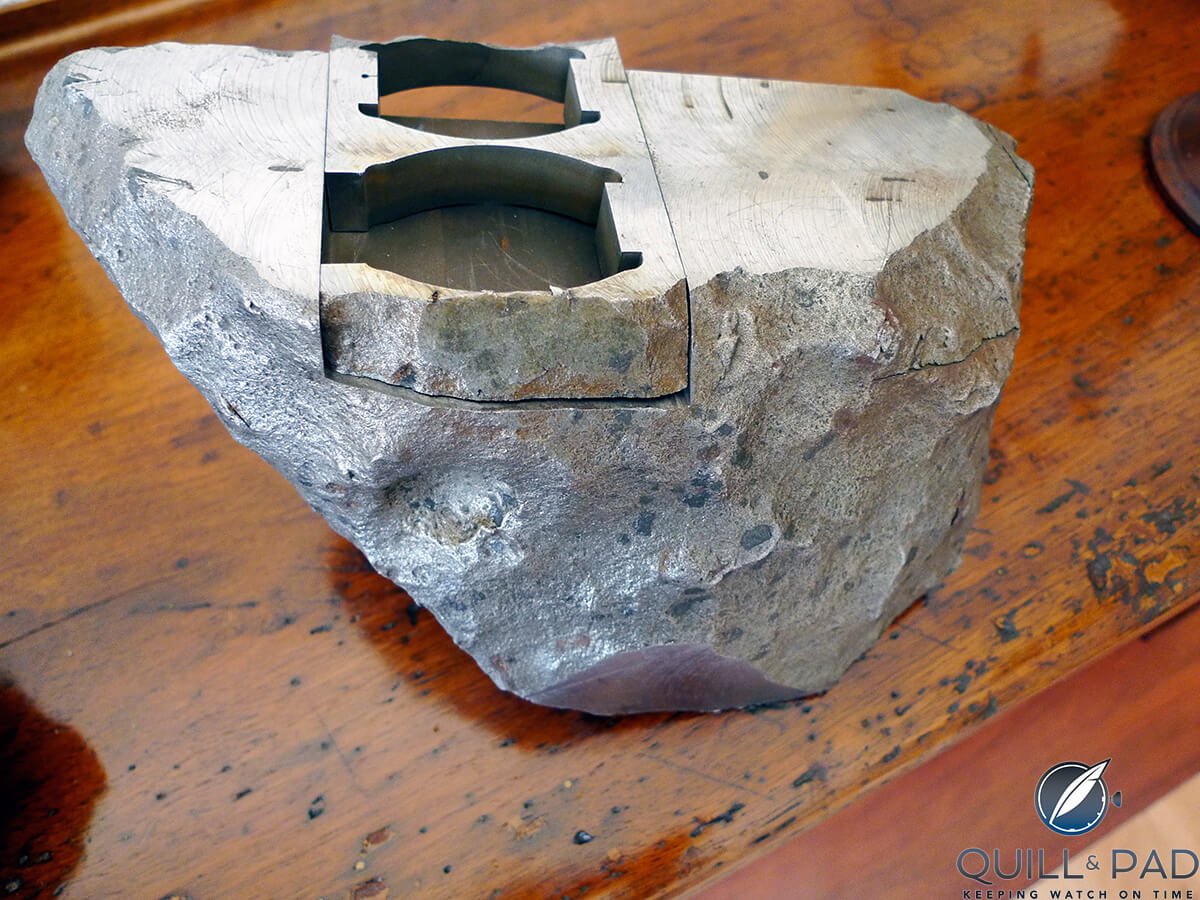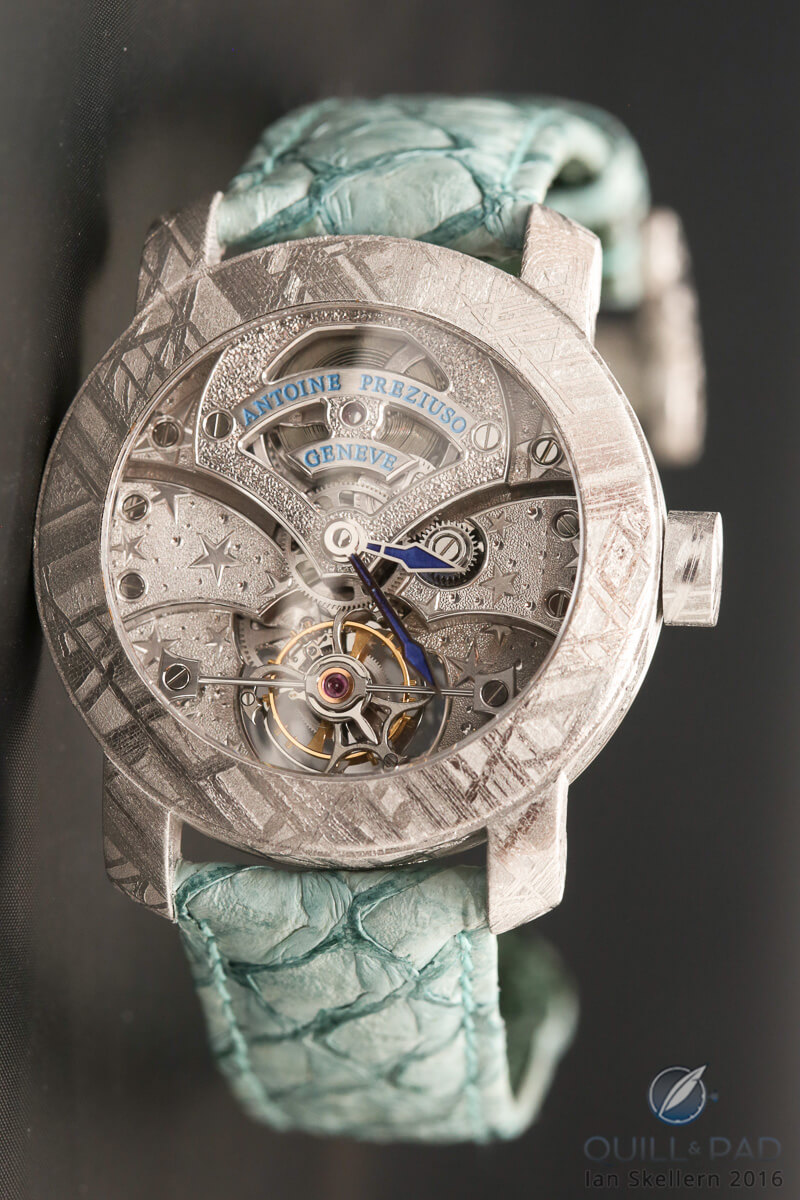Who would have pegged Antoine Preziuso for such a romantic?
The independent watchmaker who received not one, but two, awards at the 2015 Grand Prix d’Horlogerie de Genève for his extremely masculine and robust Tourbillon of Tourbillons (see Antoine Preziuso Tourbillon Of Tourbillons: Fractals Meet ‘Inception’) returned in 2016 with a watch inspired by one of his favorite elements: the heart of a shooting star.

Antoine Preziuso Stella Polare Tourbillon Muonionalusta
Let’s get this straight right from the start: despite its incredible good looks, the Stella Polare Tourbillon Muonionalusta is hardly less technical than the Tourbillon of Tourbillons in some ways thanks to both its complicated regulator mechanics, and the technical material used to prop and protect those mechanics. Despite all its scholarly technology, in my opinion the Stella Polare Tourbillon Muonionalusta is far more wearable for slimmer wrists than some of this technical virtuoso’s other creations.
And much more aesthetically pleasing.
Antoine Preziuso: A rich career
Preziuso can look back on a long and prosperous career as an independent watchmaker.
He is a Geneva-born watchmaker of Italian descent whose father was also a watchmaker (which makes his son, Florian, who works with him, the third generation of Preziuso watchmakers). Graduating in 1974 from the Geneva Watchmaking School at the top of his class, he was recruited by Patek Philippe.
By 1980 Preziuso was setting up Antiquorum’s first restoration and appraisal workshop; in 1981 he founded his own atelier at the age of just 24. It was then that he joined the Cabinôtiers de Genève, a predecessor to the A.H.C.I., which was likewise founded by A.H.C.I. co-founder Svend Andersen. Preziuso both worked on developments for major watch companies and his own unique timepieces before ultimately launching his own brand in 1990. He first exhibited at Baselworld as a candidate member of the A.H.C.I. in 1995, becoming a full member in 1996.

The Opus 2 by Antoine Preziuso for Harry Winston
Preziuso’s visibility among a wider watch collecting public was heightened when he created the Opus 2, the second Harry Winston Opus for the newly founded Harry Winston Rare Timepiece division headed up by then-CEO Maximilian Büsser released in 2002 (see The Harry Winston Opus Series: A Complete Overview From Opus 1 Through Opus 13). Today, Preziuso’s business is a tight-knit family affair.
Antoine Preziuso: A long-standing love affair
The women in Antoine Preziuso’s immediate family – wife May and daughter Laura – focus on making jewelry, while the men – Antoine and son Florian – concentrate on watchmaking. This talented and highly creative family has naturally found a way to work together, most notably by combining both disciplines in unique pieces offered in the “By Laura Preziuso” line.
Therefore it should not come as so surprising that Antoine has a real eye for aesthetics. And, emerging from this, it can truly be said that he has played a pioneering role in the use of meteorite in watchmaking.
Antoine began getting more and more interested in astronomy as a young watchmaker and finally hit upon the idea of contacting a meteorite hunter to see if it were possible to find the right kind of material for use in his own personal art of watchmaking. It was a long and complicated journey to find his desired piece of the sky, but he found it – and his love of the material has stayed with him all this time.
Seduced by the beauty of meteorite in addition to its philosophical and symbolic representations, his imagination was stimulated – and incredibly tantalizing and rare unique pieces have emerged from his workshop in a consistent manner.
Meteorite is ferrous “stone” that is actually a piece of iron-rich space rock that at some point entered our earth’s atmosphere and landed on terra firma, waiting to be found.

Cutting a watch case for the Antoine Preziuso Stella Polare Tourbillon Muonionalusta from meteorite
Meteorites are named for the places they are found, and Preziuso prefers to work with two going by the names of Gibeon and Muonionalusta. These two iron-nickel-based meteorites exhibit prominent Widmanstätten structures – the typical striations and patterns that become evident once the material is subjected to a chemical bath.
Gibeon, believed to have fallen to earth in prehistoric times, was found in Namibia, while Muonionalusta, first found by children in Sweden in 1906, is estimated to be about one million years old.

Case of the Antoine Preziuso Stella Polare Tourbillon Muonionalusta cut from a slice of meteorite
The raw stone comes from meteorite hunters, who must provide a large enough block from which Preziuso must be able to cut a case. Slices are first cut by wire spark erosion to get the general size. Once that is achieved, the cutout is sent back to the spark erosion bath to make the precise case shape.
Then the case is then precision-milled by a CNC machine to add the necessary technical features such as holes for screws and the crown, grooves for the case back, and other elements. Then the case is cleaned, polished, and soaked in acid, which allows the meteorite structure to fully materialize.
The final step is to coat it with rhodium for that beautiful silvery glow that Preziuso’s meteorite cases generally exhibit or black gold for a more yellow glow, which some of Preziuso’s meteorite watches also have. The coating does more than embellish the color; it also protects the material.
Preziuso brought his first timepiece containing meteorite out in 1991, long before anyone else was dabbling in such a difficult-to-work material. The first watch he created with it was 1991’s Quarter Repeater, which was outfitted with a Gibeon meteorite dial and a rotating bezel that acted as the repeater trigger.
About a decade later, in 2002, he introduced the Tourbillon Meteor, uniquely housed in a meteorite case, followed by the Tourbillon Muonionalusta of 2004, for which he employed that new type of meteorite for the first time.

The New Art of Tourbillon Meteor by Antoine Preziuso from 2006
The New Art of Tourbillon Meteor from 2006 and the Next Full Moon of 2007 featured not only case and dial made of the material, but at times even hands and buckles. Next Full Moon was a watch that also revealed Preziuso’s playful mechanical side: a red hand points to a date display at 2 o’clock, whose sole purpose is to alert the wearer when the next full moon will be seen in the night sky. A large moon phase display in the opposite corner of the dial between 7 and 8 o’clock offsets it.
To date, Preziuso has produced ten timepieces using Muonionalusta meteorite.
Stella Polare Tourbillon Muonionalusta
This brings us right up to the now, and the latest in line as well as the first in a small new series of meteorite timepieces by Preziuso: the Stella Polare Tourbillon Muonionalusta, whose name tells us exactly what this watch is all about (“stella polare” means “polar star” in Italian). The “polar” bit refers to the Arctic Circle, which is where the Muonionalusta meteorite came to rest.

Antoine Preziuso Stella Polare Tourbillon Muonionalusta
This particular model is conceived as a watch for women, though I personally find it to be quite unisex depending on the strap attached to it. The light green strap it currently wears, which perfectly offsets the textures of the meteorite case and visible hand-engraved bridges and plates of the movement, is made of Nile perch lined with lizard skin.
Perhaps it is the various textures of this watch that make it seem feminine: the Nile perch strap, which is dyed to enhance the contrast, is graced with large scales not unlike snakeskins that are used for watch straps. The strap is not only casually luxurious, but also quite modern in its style.

Antoine Preziuso Stella Polare Tourbillon Muonionalusta
The Widmanstätten patterns of the Muonionalusta meteorite embellishing the 40 x 10 mm case are clearly visible, while the hand-engraved bas relief stars of varying sizes and craters in between them cover the large central bridges and plate peeking out underneath in the lower third of the dial area.
The upper plate looks as if it might be set with gems if you just glance at it quickly since it sparkles so brilliantly. Upon closer perusal, you discover that it’s really another set of craters placed much more closely to each other. The effect is a brilliant shine that catches the light playfully – like a starry sky in a remote location on an ultra-clear night.

Antoine Preziuso Stella Polare Tourbillon Muonionalusta
This is an excellent example of the engraver’s art; it even fooled my experienced eye the first time I saw it.
The combination of all of these various textures is nothing short of enchanting: the compelling allure I felt inside was real and visceral.
Thank goodness this watch has no real dial to cover up the intriguing view of the richly decorated plates and bridges – which almost pull the entire attention away from that which should be the main focus: the one-minute tourbillon beating its heart away at 6 o’clock.
Between all of those attention-grabbing elements, you almost don’t even realize that the richly cratered plate at 12 o’clock covers a large spring barrel, which is only slightly visible through the openworking.
Oh, and the back of the Antoine Preziuso Stella Polare Tourbillon Muonionalusta!
If you turn the watch over, the bedazzling view (including the lizard skin on the strap) is amplified, but the spring barrel becomes more visible thanks to a strategically placed cutaway. This spring barrel should be hard to miss because it contains a mainspring large enough to power this incredible manually wound watch for 110 hours without having to wind again.

View through the display back of the Antoine Preziuso Stella Polare Tourbillon Muonionalusta
The case back made of white gold also features two small stars set with brilliant-cut diamonds replicating shooting stars. A large expanse of sapphire crystal reveals the entire enthralling beauty of the movement.

A close look at the back of the Antoine Preziuso Stella Polare Tourbillon Muonionalusta
The base plate continues the star-and-crater engraved design from the front, but adds a shooting star on the right side, whose tail features the words “Stella Polare” in blue engraved-and-lacquered letters that continue the blue theme from the lettering and hands on the front of the watch.
“I designed this watch because it made me dream,” Preziuso said. Thank you, Antoine, for doing that because now you’ve also made me dream.

Antoine Preziuso Stella Polare Tourbillon Muonionalusta
For more information, visit www.antoine-preziuso.com.
Quick Facts Antoine Preziuso Stella Polare Tourbillon Muonionalusta
Movement: manually wound Preziuso caliber T.21 with one-minute tourbillon and 110 hours power reserve
Case: Muonionalusta meteorite and white gold (case back), 40 x 10 mm
Functions: hours, minutes
Limitation: unique piece within a limited series
Price: 240,000 Swiss francs
* This article was first published on August 11, 2016 at Antoine Preziuso Stella Polare Tourbillon Muonionalusta Fell From Heaven.
You may also enjoy:
Romain Gauthier Prestige HMS Stainless Steel With Rare Henbury Meteorite Dial





















































Leave a Reply
Want to join the discussion?Feel free to contribute!